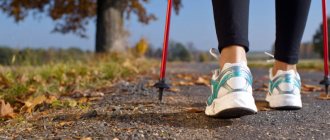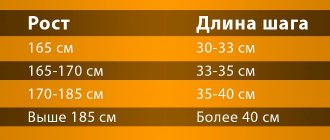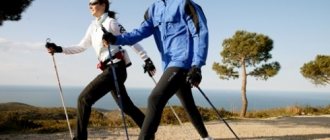Walking is a gentle cardio workout that can help you lose weight and improve your body composition. Walking exercises your entire body's muscles, increases your calorie expenditure, and thus helps you burn fat, which can help reduce the amount of visceral fat in your body (the most dangerous type of fat) that typically accumulates around your waist.
If you are looking for an easy way to lose weight, then start with walking for weight loss. This type of activity will fit into any schedule and is suitable for any age and level of physical fitness. Below are tips and recommendations on how to walk correctly to lose weight for women and men, the implementation of which will help reduce fat in the abdominal area.
Keep an eye on your pulse
The first step to combating excess weight around the waist is to increase your heart rate while walking to the level at which fat begins to be used as the main source of energy. To achieve a certain intensity, your heart rate should be 60-70% of your maximum heart rate.
You can calculate your maximum heart rate by subtracting your age from 220. Once you have determined this number, you can use a fitness app such as MapMyFitness to determine your 5 heart rate zones. The fat burning zone is zone 2. Using a fitness tracker along with a heart rate monitor is the easiest way to make sure you're in the right zone while exercising.
Remember that as your heart rate increases, more calories are burned. However, this does not mean that more calories are burned if your heart rate is in zones 3, 4 or 5. These zones use sugar and carbohydrates for energy, with 85% of the calories burned coming from fat stores and the remaining 15% from carbohydrates and protein.
If you're having trouble maintaining a speed that allows you to stay in Zone 2, try power walking, Nordic walking, or walking on an incline treadmill or trail to increase the intensity.
Long live diversity!
Try different types of walking activities:
- Walking on a treadmill for weight loss . For such a workout, you don’t need to leave the house in bad weather; the treadmill makes it easy to control your heart rate and load. The downside is the lack of fresh air and visual impressions.
- Nordic walking allows you to burn 46% more calories than regular walking. During training, more diverse muscle groups are activated. This workout is suitable for the older generation and people with significant excess weight.
- Interval walking differs from regular walking by alternating slow and fast walking - for weight loss, such training is more effective than regular walking at a constant speed.
- Walking up stairs allows you to burn a maximum number of calories (up to 500 per hour), while the energy consumption when going up will be much greater than when going down.
- Walking with an upward slope allows you to burn calories more efficiently, the higher the angle of inclination. It combines strength and cardio exercise and helps strengthen the muscles of the buttocks and legs.
- Walking in place is less effective than walking on the street or on a treadmill, but it still allows you to burn more calories than at rest. To increase its effectiveness, it is advisable to actively work with your hands.
Increase your workout duration
During short sessions of 30 minutes, glycogen and carbohydrates will be used as energy. Due to the fact that these reserves are negligible, fat will also be burned. The key to success will be to increase the duration to 45 minutes or more.
It's okay if you're new to this and will spend less time, and then start adding 5-10 minutes to your workout every week until the duration reaches the point where fat is used as the main source of energy . Schedule the class on weekends or days when you have more free time, so it lasts approximately 90 minutes.
Walking for weight loss: how much should you walk?
It is believed that the normal level of physical activity for a healthy person corresponds to 10 thousand steps. This number of steps allows you to cover a distance of about 8 km.
The theory of 10,000 steps was born in Japan in the mid-60s, simultaneously with the advent of the first electronic pedometer. Modern research confirms its correctness. Now a person’s lifestyle is characterized based on the number of steps he takes during the day:
| Number of steps per day | Lifestyle |
| less than 5 thousand | sedentary |
| 5 -7 thousand | sedentary |
| 7-10 thousand | moderately active |
| 10 - 12.5 thousand | active |
| More than 12.5 thousand | very active |
To effectively help you lose weight, you must walk continuously for 60 minutes or more - only in this case the body will begin to use up the fat reserves accumulated earlier.
Don’t try to immediately set yourself the goal of walking for one and a half to two hours or walking a distance of 20 km. Even an hour-long walk can be too tiring for an unprepared person. Start with half-hour workouts, gradually increasing their duration.
Sample walking program for weight loss:
- First week: 4 days, 30 minutes
- Second week: 5 days of 40 minutes
- Third week: 6 days of 60 minutes.
Then you can increase the duration of the workout, but you should leave one day a week for rest and recuperation.
Alternate loads
This type of training has low or medium intensity, i.e. if you do it every day, there is no risk of injury, as with high-intensity training.
Doing the same exercises every day can lead to mental fatigue, burnout, and developmental stagnation. For this reason, if losing weight is your main goal, it is recommended to train in zone 2 3-4 times a week.
From time to time, you can alternate aerobic exercise with strength exercises that are shorter in duration. Exercises done in Zones 3, 4, and 5 will help you improve your walking speed, build muscle mass, and burn more calories in a shorter period of time. High intensity workouts can also be ideal on days when you don't have much time.
How to make walking more efficient
If you exceed the daily caloric intake, it is impossible to lose weight with just walking, even with daily walks. Diets will not help either, because they give a short-term effect. We need to completely reconsider our diet. Weight loss will occur faster if you give up sweets, fatty, fried foods.
It is better to replace these dishes with vegetables, fruits and other healthy foods. In addition, a quick weight loss step will be effective if:
- Maintain drinking regime. Water helps burn calories. However, you should avoid drinks that contain a lot of calories and sugar. As a rule, on average a person should consume from 1.5 to 2.5 liters per day; during training, you can drink in small sips.
- Do a warm-up. If a person chooses the interval mode, then a quick step on an unheated body will lead to injury. Walking should begin at a slow pace, and a series of warm-up exercises should be performed before climbing stairs.
- Choose the right shoes. You need to choose comfortable sneakers. To walk on a flat surface, you need to buy flexible, lightweight shoes with low heels or hard boots that will prevent you from stumbling when moving from side to side.
- Think over the route. For a walk to be beneficial, it is better to do it in a park or forest. It’s good when the road goes through rough terrain, where there are ups and downs.
- Add strength exercises. This will help you lose excess weight faster. After 5 minutes of walking, you should stop for a minute to perform lunges, jumps, and squats.
Sport equipment
All you need to walk is good shoes and time. There are items that can help make your workout easier and more productive.
Below is a list of equipment that will help you lose weight:
- Heart Rate Monitor: Helps you monitor your heart rate zone.
- Nordic walking poles: improve gait and posture.
- Pedometer: Counting steps is a good way to keep track of your daily goals and challenge yourself during your workout.
- Dumbbells: Will tone your upper body and raise your heart rate without the need for brisk walking.
- Fitness apps: Activity tracker helps you track distance, time, step rate and heart rate.
Useful video
Watch the video about fast walking techniques:
Similar articles
- Walking with weights for weight loss
Both athletes and beginners use weights for weight loss. To prevent exercises from injuring your joints, you should start with the simplest and shortest activities - running around the house, walking for a walk. Even regular leg exercises with weights will give an excellent effect. Read more - Nordic walking for weight loss: benefits...
It is believed that Nordic walking is more effective than running for weight loss. Its benefits are noticeable for both the heart and joints. Only the correct technique for practicing with sticks will give excellent results. Nutrition afterwards is also important. Read more
- Stepper for weight loss: is it effective, benefits...
A simple stepper for weight loss can give excellent results. Its benefits are also noticeable for the entire ODA. Special exercises will pump up your legs and effectively help you get rid of fat. It is important to figure out how to conduct classes at home, including on a mini-stepper. Read more
Walking plan for weight loss for 4 weeks
If you're looking for a way to burn more calories while walking, then it's time to incorporate strength training into your workout.
Whether you're just starting out, getting back into exercise after a long break, or are a regular hiker, this four-week plan combines moderate-to-vigorous exercise and includes strength training and flexibility exercises to help speed up your workouts. achieving results.
If losing weight is one of your goals, then walking regularly and counting calories may be the best way to achieve your goal. You can lose weight by cutting calories, but research has shown1 that dieting and exercise can speed up the process. To lose weight quickly, it is recommended to combine a diet of 1800 calories per day with exercise, during which you will burn 300 calories.
If you want to improve your performance, make it easier to count calories, and make sure you're getting all the nutrients you need without the extra calories, use sports nutrition. Protein is great for controlling the amount of protein in your diet, L-carnitine will help you burn more calories, and vitamins and omega-3 fatty acids will help maintain a high metabolic rate.
We've created this 5-day-a-week exercise plan that will help you burn approximately 300 calories per day. (Keep in mind that the number of calories burned is approximate and may vary depending on the individual characteristics of the body, body composition, level of training, etc. For a more accurate determination, you can use a heart rate monitor or other similar device.) On weekends You can exercise and/or find a way to move more, such as gardening, cycling, roller skating or playing with children, etc.
Although this is a walking plan for weight loss, we recommend incorporating strength exercises and stretching to enhance the effectiveness of your body contouring and weight loss plan and help prevent pain.
| Day 1 | Walking at a change of pace + stretching |
| Day 2 | Power training |
| Day 3 | Walking at a steady pace + stretching |
| Day 4 | Power training |
| Day 5 | Walking at a change of pace + stretching |
| Day 6 | Power training |
| Day 7 | Leisure |
Running or walking for weight loss - which is more effective?
When people talk about simple physical activity for weight loss, the first thing that comes to mind is jogging. However, it is not suitable for everyone. For example, starting running for physically unprepared people, especially in adulthood, is quite risky:
- there is a high probability of injuries to joints and tendons;
- during running, the load on the heart muscle increases significantly;
- It is extremely difficult for people with significant excess weight to run.
Walking at a moderate pace is accessible even to obese older people, and it is an even more effective way to burn fat reserves.
Interesting: Experiments have shown that – in 60 minutes of running you can burn about 550 kcal, 50% of which comes from fat; - in 60 minutes of walking, the number of calories burned is slightly less - 350, but the percentage of fat tissue that melts is as much as 65%.
In terms of its health-improving effect, walking training at a moderate pace is not inferior to popular running, but, unlike it,
- has no health restrictions;
- safe from injury;
- is a natural form of activity.
Weekly goal and change of pace
Following this plan and combining walking, strength training and stretching will help you burn 300 calories a day. Walking 3 times per week, strength training 2-3 times per week, and flexibility exercises 2 times per week (or more) are recommended, but the plan should be adjusted based on your current fitness level and schedule. Do 4 sets and watch yourself get stronger each week.
Walking with changes in pace (30-40 minutes)
Start walking at your normal speed for 5 minutes to warm up your body, then do interval training for 20-30 minutes using a 2/2/1 pattern.
- 2 minutes: Walk at a brisk pace at a steady pace (intensity 5 out of 10, you should be able to speak but your breathing is rapid)
- 2 minutes: move at a fast, steady pace (intensity 7/10, you should be able to answer questions, but not have a full conversation)
- 1 minute: increase the speed as much as you can, swing your arms to increase the speed (intensity: 8/10, should be challenging but doable within 60 seconds)
Endurance training: walking at a constant pace (40-50 minutes)
Start by walking at a normal pace for 5 minutes to warm up your body, then continue at a fast pace (intensity 5-6) for 30-40 minutes. Rest for 5 minutes and walk at a normal pace to restore your breathing and heart rate (you can finish the workout with a full-body stretch)
Strength training (20-30 minutes)
Perform exercises to increase strength, use dumbbells, fitness bands or other sports equipment that you prefer.
A good way to break up your walking, strengthen your muscles, and burn more calories is to incorporate exercise into your workout. Two or three times a week will be enough. Just stop and do one of these exercises while you walk. How many approaches you do is up to you:
Push-ups (do them from a park bench or from a wall to make it easier)
Squats: Bend your knees 90 degrees
Walking lunges
Classic and side plank
Stretching (3-15 minutes)
Stretching can be done immediately after walking if you can, or at any other time. Focus on stretching your entire body, paying special attention to areas of the body with tight muscles.
Leisure
Take a break from your workouts by stretching, gardening, cycling, or walking around the neighborhood. You are resting, but you are on the move.
How to Walk for Weight Loss
To begin the process of losing weight, you need to spend at least 2 hours a day walking:
- It is advisable to do this in the morning after a light breakfast. By exercising early, it is easier to create a calorie deficit, and the body will begin to consume fat reserves more intensively. In the morning, metabolism accelerates, so many calories will be consumed throughout the day.
- You can train in the evening, the main thing is to complete the exercise two hours before bedtime.
Features of walking for weight loss:
- For beginners, it is better to walk for no more than 60 minutes, and the speed should be 3–4 km per hour. Having gained experience, you can increase the duration of training to 3 hours and the speed to 8 km. An approximate version of a week's walking: 3 days at a fast pace you need to walk for 30 minutes, 2 - 45 minutes, and on one day - only an hour.
- You don't need to track your heart rate every day, but you should do it periodically. This is necessary to regulate it, because with a high heart rate, the body spends not fats, but carbohydrates, so instead of losing weight, a person will feel weak. The permissible frequency is easy to calculate: you should subtract your age from 220, and the resulting number should be multiplied by 0.65.
- For convenience, you can purchase a special pedometer, with which you can easily determine the optimal distance and number of steps for each person.
Walking at a fast pace
For older people, it is better to give up a fast pace of walking in favor of a moderate one, but you can increase the duration of the walk and the distance. But for young people, an intense step will help them lose excess weight faster. Peculiarities:
- Before walking, be sure to drink a glass of water; you need to take a small bottle with you. While walking, you can take a few sips, but do not become dehydrated.
- It is advisable to start walking every day for 30 minutes, gradually increasing the time. It's better to do 1,000 steps first.
- Correct foot placement is necessary to reduce the load on the spinal column. You should smoothly roll your body weight from heel to toe, while trying to lean on the outer side of the foot and push off harder - work equally with both legs.
- It is better to walk in small steps, vigorously moving your arms. This will increase calorie expenditure and reduce fatigue.
- The arms should move in sync with the legs. This is necessary for balance.
- You need to breathe correctly. Inhale through the nose, exhale through the mouth. To restore breathing, you need to slow down for a while. At a high tempo, you can inhale air through your mouth and nose at the same time, and exhale only through your mouth.
- It is necessary to try to maintain an even posture throughout the walk, this will help you move faster. You need to keep your spine and neck straight, align your shoulders over your hips and look forward. This will allow the muscles to work energetically.
- For greater weight loss, you can take fewer steps, but still walk faster. You should take 2000 steps per 1.5 km. This will change the speed and the weight will come off faster.
- It is necessary to reduce the pace gradually so that the muscles do not hurt. You should slow down and walk slowly until your heart rate returns to normal.
Fast walking on a treadmill
Race walking on a treadmill helps develop endurance, gets rid of excess fat, and improves metabolic processes. The effectiveness of a weight loss program on a simulator depends on the choice of time of day. The ideal option for fat burning is the morning before breakfast, because at this time the level of glycogen in the muscles is minimal. The main source of energy is visceral (subcutaneous) fat.
Peculiarities:
- To avoid injury, you should warm up before training. The body must be in the correct position. You need to straighten your shoulders and chest, tighten your abs a little, straighten your back, and bend your arms at the elbows so that they form a right angle.
- Steps during training should be of the same length. You need to breathe deeply and through your nose.
- Alternating fast walking with running helps increase endurance and develop the respiratory system. An excellent option is interval training (alternately walking and at a fast pace). The load can be increased by choosing to walk with an incline on the running belt or with weights on your legs.
- It is better to complete the workout by walking at a walking pace (10–20 minutes).
- Be sure to drink clean water before and after training. It is better to take a couple of sips every 10 minutes to prevent dehydration.
- The weight loss program is individual, but it should be one hour a day. Some trainers recommend exercising every other day with intense exercise. To begin with, it is better to start with twice a week, gradually increasing the load. The optimal time on the treadmill is 60 minutes.
- It is recommended to include walking in your training program after strength training. Cardio exercise will increase calorie expenditure, which will provide an increased fat burning effect.
- When exercising, you should monitor your pulse. It is advisable that during training it does not fall below 130 beats per minute and does not exceed 135.
Walking: Tips for Quick Weight Loss
Adapt the plan to suit your fitness level and schedule. If you're just starting out, you can reduce the number of classes per week and shorten their duration. Every week, train 1 day more or extend the session by 5 minutes to gradually increase the load without overworking. Tailor your plan to suit your needs and preferences to make it easier to stick to, because consistency is the key to achieving (and maintaining) results!
Remember that during strength training, fewer calories are burned, but muscles are pumped, i.e., more metabolically active tissue is formed (muscle tissue burns more calories at rest than fat). Don't worry if you don't burn 300 calories on your strength days, because you are making important changes to your body by doing this type of exercise, which helps change your body composition in the long term.
Use these tips to burn calories quickly and lose weight:
Walk more during the day
Brisk walking is the best way to keep fit. Stick to 30-45 minutes of walking per day.
Throughout the day, try to take an extra walk of 20 minutes a day or less whenever you can to help you reach your weight loss goal. Here are some tips to help you get started:
- Taking a walk before meals will help control blood sugar levels, prevent overeating and speed up your metabolism.
- If you need to move from one destination to another over short distances, then walk rather than use transport.
- If you're not in the mood or feel like you're on the verge of stress, taking a short walk will not only boost your mood, but also help you burn some calories.
- Do not use the elevator, but take the stairs.
Increase the intensity
Increasing your walking speed is one way to get your heart beating faster and burn more calories. Ohio State University scientists have found that alternating your speed while walking can help you burn 20% more calories than walking at the same pace.
When walking, take 30 seconds out of every 5 minutes and walk as fast as you can, but don't run. Do this type of activity before returning to your normal pace.
Conquer heights
Walking on hilly terrain is one way to incorporate intervals into your walk without creating agony. Walking uphill burns more calories and helps build lean body mass, which also helps speed up your metabolism.
If there is no such area nearby, and you cannot afford to exercise 2-3 times a week, then try to walk up the stairs or exercise in the gym on a treadmill with an increased incline angle.
Remember to change your technique a little. When lifting, lean forward, take shorter steps, and bend your knees more than usual.
Use your hands
Even though it may seem silly, swinging your arms as hard as you can will provide extra benefits. It will help you increase your speed, work your whole body, and burn 10% more calories compared to your normal arm swing.
Use the following tips to help you curl your arms correctly:
- Bend your arms 90% and maintain this shape.
- The arm should extend behind the body as far as you can naturally and naturally.
- On the way up, your arm should rise to chest level.
Set a goal
Setting goals is important to maintain motivation. One goal could be to increase the steps taken per day. The more you walk in a day, the more calories you will burn. Reducing your stride size to take more steps can help speed up your pace.
Increasing the number of steps is safe, unlike distance and speed, which if increased too quickly can cause injury. If you're serious about losing weight, start with 10,000 steps and add as many steps as you can get to that number.
Sources:
- https://www.ncbi.nlm.nih.gov/pmc/articles/PMC3406229/
- https://blog.myfitnesspal.com/walk-in-the-fat-burning-zone-to-blast-belly-fat/
- https://blog.myfitnesspal.com/4-week-power-walking-plan-weight-loss-2/
- https://blog.myfitnesspal.com/4-common-walking-mistakes-that-lower-your-calorie-burn/
- https://blog.myfitnesspal.com/7-walking-tips-to-lose-weight-faster/
The benefits of walking in place
This type of physical activity is considered one of the least traumatic and stressful for the body. Moreover, walking in place not only benefits your figure, but also engages all body systems. When performed regularly it:
- accelerates blood circulation, saturates tissues and cells with oxygen;
- strengthens the cardiovascular system, reduces the risk of thrombosis, stroke and heart attack;
- regulates blood sugar levels and removes “bad” cholesterol;
- strengthens bone tissue;
- normalizes blood pressure;
- increases a person’s overall endurance, eliminates shortness of breath;
- normalizes sleep;
- relieves nervous tension and improves mood.
Such activities have no contraindications. Due to their gentle load, they are suitable for both pregnant women and the elderly. And also in the presence of any chronic diseases. Walking in place is often prescribed even to those who, in principle, are prohibited from high loads. Of course, the intensity of the exercise should not be too high - you need to walk at an average pace.
What other benefits are there from walking besides losing weight?
Walking is a wonderful leisure activity. In addition to losing weight, you will also be able to enjoy beautiful views of nature and breathe fresh air, unless you live near a metallurgical plant.
Walks in parks, on embankments and in other beautiful places can also relieve you psychologically. Relax after work or, on the contrary, recharge your batteries for the upcoming working day.
You can also choose walking instead of public transport or a personal car. This will save both nerves and money. Public transport is like Satan’s ball, and I’m generally silent about traffic jams.
Approximate walking schedule
How much to walk a day to lose weight? Here is an example of a walking schedule. You can increase or decrease the time depending on how your body reacts.
| A week | Day 1 | Day 2 | Day 3 | Day 4 | Day 5 | Day 6 | Day 7 |
| 1 | Walking at a slow pace - 10 minutes | Walking at a moderate pace - 20 minutes. | Walking at a moderate pace - 20 minutes. | Walking at a moderate pace - 20 minutes + exercise | Walking at a moderate pace - 30 minutes + exercise | Interval walking - 20 minutes + exercises | Rest |
| 2 | Interval walking - 30 minutes + strength training | Walking at a high pace - 5-10 minutes + exercises + strength training | Walking at a fast pace - 10 minutes + exercises + strength training | Walking at a moderate pace - 15 minutes + free exercise - 15 minutes | Interval walking - 20 minutes + Kapalbhati - 15 minutes (rest in between) | Interval walking - 30 minutes + strength training | Rest |
| 3 | Interval walking - 40 minutes + Kapalbhati - 15 minutes (rest in between) | Walking at a moderate pace - 15 minutes + exercises + strength training | Interval walking - 45 minutes + strength training | Walking at a high pace - 15 minutes + exercises | Interval walking - 50 minutes + free exercise - 10 minutes | Walking at a high pace - 20 minutes + exercises + Kapalbhati | Rest |
| 4 | Walking at a high pace - 20 minutes + strength training | Interval walking - 60 minutes | Interval walking - 60 minutes + exercises | Interval walking - 60 minutes + strength training | Interval walking - 60 minutes + free exercise | Interval walking - 60 minutes + exercises + Kapalbhati | Rest |









